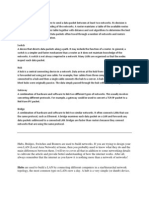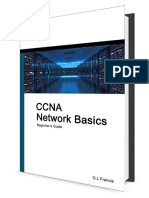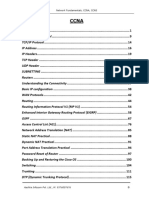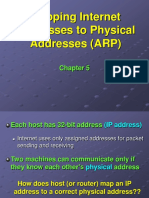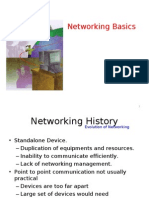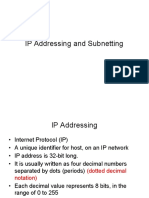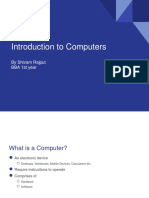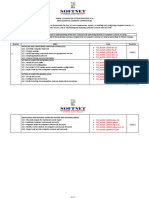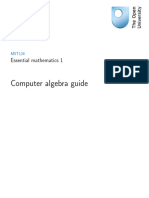0 ratings0% found this document useful (0 votes)
49 viewsIT Infrastructures Computer Communication Networks
IT Infrastructures Computer Communication Networks
Uploaded by
sohilnandwani09The document provides an overview of computer communication networks and IT infrastructures. It discusses basic network concepts including network architecture, different network layers, and common network types like LANs, WANs, intranets and the internet. It also covers network components, topologies, protocols and standards like TCP/IP.
Copyright:
Attribution Non-Commercial (BY-NC)
Available Formats
Download as PPT, PDF, TXT or read online from Scribd
IT Infrastructures Computer Communication Networks
IT Infrastructures Computer Communication Networks
Uploaded by
sohilnandwani090 ratings0% found this document useful (0 votes)
49 views39 pagesThe document provides an overview of computer communication networks and IT infrastructures. It discusses basic network concepts including network architecture, different network layers, and common network types like LANs, WANs, intranets and the internet. It also covers network components, topologies, protocols and standards like TCP/IP.
Original Title
IT+Infrastructures
Copyright
© Attribution Non-Commercial (BY-NC)
Available Formats
PPT, PDF, TXT or read online from Scribd
Share this document
Did you find this document useful?
Is this content inappropriate?
The document provides an overview of computer communication networks and IT infrastructures. It discusses basic network concepts including network architecture, different network layers, and common network types like LANs, WANs, intranets and the internet. It also covers network components, topologies, protocols and standards like TCP/IP.
Copyright:
Attribution Non-Commercial (BY-NC)
Available Formats
Download as PPT, PDF, TXT or read online from Scribd
Download as ppt, pdf, or txt
0 ratings0% found this document useful (0 votes)
49 views39 pagesIT Infrastructures Computer Communication Networks
IT Infrastructures Computer Communication Networks
Uploaded by
sohilnandwani09The document provides an overview of computer communication networks and IT infrastructures. It discusses basic network concepts including network architecture, different network layers, and common network types like LANs, WANs, intranets and the internet. It also covers network components, topologies, protocols and standards like TCP/IP.
Copyright:
Attribution Non-Commercial (BY-NC)
Available Formats
Download as PPT, PDF, TXT or read online from Scribd
Download as ppt, pdf, or txt
You are on page 1of 39
IT Infrastructures
Computer Communication Networks
• IT Infrastructure is a combination of Software,
hardware and other equipments that support the
activities of an organization.
• Basic Concept of Network
• Network Architecture
• Different Layers
• Work group technologies
• Intranet
• Extranet
• Internet
Basic Concept of network
• A computer network is a data communication
system where two or more computers are
linked in order to exchange data(documents,
sheets etc.) and share resources (CD-ROM ,
printers, etc).
• The computers on the network can be linked
through Cables, telephone
lines,satellites,radio waves etc.
Classification of Networks
• PAN-A personal area network (PAN) is a computer network used for
communication among computer devices (including telephones and personal
digital assistants ) close to one person.
• Local Area Network(LAN)-A local-area network is a computer network covering a
small geographic area, like a home, office, or group of buildings e.g. a school
• CAN-Campus Area Network- A 'campus area network'('CAN') is a computer
network made up of an interconnection of local area network (LANs) within a
limited geographical area. Ex- academic departments, the university library and
student hostels.
• Metropolitan network(MAN)-Metropolitan area networks, or MANs, are large
computer networks usually spanning a city. They typically use wireless infrastructure
or optical fiber connections to link their sites.
• Wide Area Network(WAN)-Wide Area Network (WAN) is a computer network
that covers a broad area(i.e., any network whose communications links cross
metropolitan, regional, or national boundaries ). Or, less formally, a network that
uses routers and public communication links. Ex-Internet
Disadvantages-LAN
• LAN-
Difficulty in sharing-slow down network
Virus threat-spread more easily
Security issues-if user and password known
Common server-if server break down, data lost
Complex Architecture-require maintenance
Components of a Network
• Network Interface Card(NIC) –This is a Network
interface controller allows a computer to communicate
over a network.
• Cable: A network cable is a physical medium through
which two network devices communicate with each
other for data transfer.
• Hub: A Hub is a central connecting point for all the
network devices via network cables.
• Protocol: A protocol is a set of rules regarding
communication that ensures that all the computers in
the network communicate in the same form.
Classification of Networks
• Point-to-Point Network
• Broad Cast Networks
Typical range of allocation
• 10 m Room LAN
• 100m Building LAN
• 1 km Site LAN
• 10 km City MAN
• 100 km Country WAN
• 1000 km Continent WAN
• 10000 km Planet Interconnection of WANs
Network Architecture
• Client /Server
• 3- tier Client Server
• Middle wire
• Peer to peer
• Mainframe
• Distributed
Client/Server Architecture
2-tier architecture is used to describe client/server
systems where the client requests resources and the
server responds directly to the request, using its own
resources. This means that the server does not call on
another application in order to provide part of the service.
2-tier and 3-tier
In 3-tier architecture, there is an intermediary level, meaning the architecture is
generally split up between:
A client, i.e. the computer, which requests the resources, equipped with a user
interface (usually a webrowser) for presentation purposes
The application server (also called middleware), whose task it is to provide the
requested resources, but by calling on another server
The data server, which provides the application server with the data it requires
Multi Tier
Peer to peer
• In contrast to client-server networks there is no
dedicated server in peer-to-peer architecture .
• Thus each computer in such a network is part server
and part client.
• This means that each computer on the network is
free to share its own resources. A computer which is
connected to a printer may even share the printer so
that all other computers may access it over the
network.
Network Models
• The TCP/IP Model - This model is sometimes
called the DOD model since it was designed for
the department of defense It is also called the
internet model because TCP/IP is the protocol
used on the internet.
• OSI Network Model - The International
Standards Organization (ISO) has defined a
standard called the Open Systems
Interconnection (OSI) reference model. This is a
seven layer architecture listed in the next section
What does TCP does?
• TCP Breaks information in to small chunks called
data packets and manages the transfer of those
packets from computer to computer.
• IP defines how a data packet must be formed and
to where a router must forward each packet.
• Packets travel independently to destinations. The
destination computer reassembles all the packets
depending on their identification sequencing
information.
• A packet data that confirms to the IP
specification is called IP datagram.
How does TCP/IP works?
• Every Computer and router connected to
internet is assigned with an unique IP address.
• When an organization connects to internet, it
obtains a set of IP addresses that can assigns to
its computers.
• TCP helps IP guarantee to delivery of datagram
by performing three tasks- checks datagram that
may lost, collects incoming datagram and puts
them in order, finally discards and duplicates
copies of datagrams that create by hardware.
Network layer
• The OSI Network Model Standard
• Physical Layer -The actual hardware
• Data Link Layers.
– Logical Link control (LLC) - Maintains the Link between two computers
by establishing Service Access Points (SAPs) which are a series of
interface points.
– Media Access Control (MAC) - Used to coordinate the sending of data
between computers. The 802.3, 4, 5, and 12 standards apply to this
layer. If you hear someone talking about the MAC address of a
network card, they are referring to the hardware address of the card.
• Network Layer - IP network protocol. Routes messages using the
best path available.
• Transport Layer – TCP Ensures properly sequenced and error free
transmission.
Network Layer
• Session Layer - The user's interface to the network. Determines when the
session is begun or opened, how long it is used, and when it is closed.
Controls the transmission of data during the session. Supports security
and name lookup enabling computers to locate each other.
• Presentation Layer – ASCII((American Standard Code for Information
Interchange (ASCII) . Makes the type of data transparent to the layers
around it. Used to translate date to computer specific format such as byte
ordering. It may include compression. It prepares the data, either for the
network or the application depending on the direction it is going.
• Application Layer - Provides services software applications need. Provides
the ability for user applications to interact with the network. - SMTP -
Simple Mail Transfer Protocol
• Many protocol stacks overlap the borders of the seven layer model by
operating at multiple layers of the model. File Transport Protocol (FTP)
and telnet both work at the application, presentation, and the session
layers.
Network Layer
• The Internet, TCP/IP, DOD Model
• This model is sometimes called the DOD model since it was
designed for the department of defense It is also called the TCP/IP
four layer protocol, or the internet protocol. It has the following
layers:
• Link - Device driver and interface card which maps to the data link
and physical layer of the OSI model.
• Network - Corresponds to the network layer of the OSI model and
includes the IP, ICMP, and IGMP protocols.
• Transport - Corresponds to the transport layer and includes the TCP
and UDP protocols.
• Application - Corresponds to the OSI Session, Presentation and
Application layers and includes FTP, Telnet, ping, Rlogin, rsh, TFTP,
SMTP, SNMP, DNS, your program, etc.
Protocols
• Protocols are sets of standards that define
operations and how they will be done.
Without protocols there would be much
confusion and there would be no standard to
allow computers to communicate.
Protocol Standards
• The protocol stacks include:
– TCP/IP
– IPX/SPX –Internetwork package
exchange/Sequenced Packet Exchange (Novell)
– Microsoft
– AppleTalk
– SNA –system Network Architecture(IBM)
– Other - Includes OSI, DLC and SNAP
Functions of protocol
• The function of the network protocols include:
– Packaging (IP)
– Transport (TCP,UDP-User datagram protocol)
– Network Management (ICMP, SNMP, ARP)
– Host Management (RARP, BOOTP, DHCP)
– Network Routing (BGP, EGP, IGP, RIP, OSPF)
– Mail (SMTP)
– Multicasting (IGMP)
– Application (FTP, TFTP, NFS)
Protocol Terms
• DLC - Data Link Control. This protocol operates at the data link layer and is
designed for communications between Hewlett-Packard network printers
and IBM mainframe computers. This protocol is not routable.
• EAP - Extensible Authentication Protocol is used between a dial-in client
and server to determine what authentication protocol will be used.
• EGP - Exterior Gateway Protocol is used between routers of different
systems.
• Ethernet - Ethernet is not really called a protocol. There are also many
types of ethernet. The most common ethernet which is used to control
the handling of data at the lowest layer of the network model is 802.3
ethernet. 802.3 ethernet privides a means of encapsulating data frames to
be sent between computers. It specifies how network data collisions are
handled along with hardware addressing of network cards.
• FTP - File Transfer Protocol allows file transfer between two computers
with login required. Part of the TCP/IP suite of protocols.
Protocol Terms
• HTTP - Hypertext Transfer Protocol is used to transport HTML pages from
web servers to web browsers. Part of the TCP/IP suite of protocols.
• ICMP - Internet control message protocol (ICMP) provides management
and error reporting to help manage the process of sending data between
computers. (Management). This protocol is used to report connection
status back to computers that are trying to connect other computers. For
example, it may report that a destination host is not reachable. Part of the
TCP/IP suite of protocols.
• IGP - Interior Gateway Protocol. The name used to describe the fact that
each system on the internet can choose its own routing protocol. RIP and
OSPF are interior gateway protocols.
• IMAP4 - Internet Mail Access Protocol version 4 is the replacement for
POP3.
• IP - Internet Protocol. Except for ARP and RARP all protocols' data packets
will be packaged into an IP data packet. IP provides the mechanism to use
software to address and manage data packets being sent to computers.
Part of the TCP/IP suite of protocols.
Protocol Terms
• SAP - Service Advertising Protocol packets are used by file and print
servers to periodically advertise the address of the server and the services
available. It works at the application, presentation, and session levels. Part
of the IPX/SPX suite of protocols.
• SMTP - Simple Mail Transfer Protocol is used to transport mail. Simple
Mail Transport Protocol is used on the internet, it is not a transport layer
protocol but is an application layer protocol. Part of the TCP/IP suite of
protocols.
• SNAP - Sub Network Access Protocol.
• SNMP - Simple Network Management Protocol is used to manage all
types of network elements based on various data sent and received. Part
of the TCP/IP suite of protocols
Some other Terms
• Modem
• Repeater
• Bridge
• Multiplexer
• Routers
• Brouters
• Chanel Service Units
• Gateway
• Packet switching
Some Other Concepts
• Intranet The Internet is not considered to
• Extranet be a part of the intranet or
extranet, although it may serve as a
• Internet portal for access to portions of an
extranet
An intranet is the internal network of a company .The
administrative entity closes the intranet to the rest of the
world, and allows only specific users
a company's customers may be given access to some part
of its intranet creating in this way an extranet
WWW
• How it works?
• The server-name portion of the URL is resolved into an
IP address using the global, distributed Internet database
known as the domain name system, or DNS. This IP address
is necessary to contact and send data packets to the Web
server.
• The browser then requests the resource by sending an
HTTP request to the Web server at that particular address.
• Then a typical Web page, the HTML text of the page is
requested first and parsed immediately by the Web
browser. Having received the required files from the Web
server, the browser then renders the page onto the screen
as specified by its HTML, and other Web languages.
DNS/Web server and IP Address
• A DNS stores other information such as the
list of mail servers that accept email for a
given domain.
• An Internet Protocol (IP) address is a
numerical identification (logical address) that
is assigned to devices participating in a
computer network utilizing the Internet
Protocol for communication between its
nodes
Internet
• Started in 1960s- DARPA( Defense Advanced
Research Projects Agency)-Called it ARPANET
• ARPANET combined with other network like
NSF( National Science Foundation) initiated
the NSFNET
• Other part of world also get connected, like
BITNET,CSNET,NSINET,ESNET and NORDUNET
Internet/www
• www is a system of internet servers that
supports hypertext to access several internet
protocols on a single interface.
• www uses its own protocol called http.
• Web contains a complex virtual web of
connections among a vast number of
documents,graphics,videos and sounds.
• Producing hypertext for the web is accomplished
by creating documents with a language called
HTML.
You might also like
- Computer Network Lab Lab Manual: Prepared By: Eng. Sireen HiaryDocument80 pagesComputer Network Lab Lab Manual: Prepared By: Eng. Sireen HiaryHamdallah Anwar KhasawnehNo ratings yet
- Inspiron 15 7577 Laptop Service Manual en UsDocument142 pagesInspiron 15 7577 Laptop Service Manual en UsPhlomNo ratings yet
- Work Protocols and ArchitecturesDocument51 pagesWork Protocols and ArchitecturesSaleih GeroNo ratings yet
- GatewayDocument11 pagesGateways_samitNo ratings yet
- Advance Concepts of NetworkingDocument168 pagesAdvance Concepts of NetworkingSaptarishi BhattacharjeeNo ratings yet
- Ec 407 Computer Communication: Pg. 1 Department of EceDocument25 pagesEc 407 Computer Communication: Pg. 1 Department of EceNandu V SNo ratings yet
- 01 Basic Network TerminologyDocument5 pages01 Basic Network TerminologyButdy UtomoNo ratings yet
- 12 Computer NetworksDocument72 pages12 Computer NetworksAbdullah ShahzadNo ratings yet
- EP 301 - Computer Networking FundamentalsDocument18 pagesEP 301 - Computer Networking FundamentalsShazul Afizi Zulkiflee100% (1)
- Ccna 1Document64 pagesCcna 1Nikhil ThavamNo ratings yet
- Cse 3003: Computer Networks: Dr. Sanket Mishra ScopeDocument56 pagesCse 3003: Computer Networks: Dr. Sanket Mishra ScopePOTNURU RAM SAINo ratings yet
- Hubs Are Used To Build A LAN by Connecting Different Computers in A Star/hierarchal NetworkDocument4 pagesHubs Are Used To Build A LAN by Connecting Different Computers in A Star/hierarchal NetworkVKNCKBGNo ratings yet
- 127 1 Networking Interview Questions and AnswersDocument13 pages127 1 Networking Interview Questions and AnswersManoj KarthiNo ratings yet
- Network Devices - PPSXDocument37 pagesNetwork Devices - PPSXMaricris Bejer LopezNo ratings yet
- Puter NetworksDocument28 pagesPuter Networkswaleed.khaldNo ratings yet
- Computer Network - CCNA Basics - Beginner - S GuideDocument414 pagesComputer Network - CCNA Basics - Beginner - S Guidenscinta100% (1)
- Computer Networks SlidesDocument60 pagesComputer Networks SlidesscribddownloadedNo ratings yet
- CCNA TutorialDocument143 pagesCCNA TutorialSuresh PatelNo ratings yet
- Lan, Wan, ManDocument20 pagesLan, Wan, ManCatherine JoyNo ratings yet
- Mapping Internet Addresses To Physical Addresses (ARP)Document27 pagesMapping Internet Addresses To Physical Addresses (ARP)Rahul Makwana100% (1)
- CCNA Guide To Cisco Networking Fundamentals: Basic Switching and Switch ConfigurationDocument53 pagesCCNA Guide To Cisco Networking Fundamentals: Basic Switching and Switch ConfigurationNaveed Khan AbbuNo ratings yet
- Basic of NetworkingDocument46 pagesBasic of Networkingapi-281601506No ratings yet
- Computer Network UploadDocument68 pagesComputer Network UploadMini100% (1)
- CCNA IntroductionDocument7 pagesCCNA IntroductionPankajSharma100% (1)
- Networking Fundamentals Ip AddressDocument106 pagesNetworking Fundamentals Ip AddressJefry Mateus100% (1)
- Domain 8 - Software Development SecurityDocument19 pagesDomain 8 - Software Development SecurityRasika Sampath AprNo ratings yet
- Network: Types and Topologies Network: Types and Topologies: by by Bhupendra Ratha, Lecturer Bhupendra Ratha, LecturerDocument53 pagesNetwork: Types and Topologies Network: Types and Topologies: by by Bhupendra Ratha, Lecturer Bhupendra Ratha, LecturerManish JangidNo ratings yet
- Chapter 2-2 - Network TopologiesDocument27 pagesChapter 2-2 - Network TopologiesAfendey Athur Jinir100% (1)
- Networking ConceptDocument81 pagesNetworking ConceptMaghair100% (1)
- Presentation ON Ccna: TRAINED BY - Kundan Singh (Aptron Solutions PVT LTD)Document36 pagesPresentation ON Ccna: TRAINED BY - Kundan Singh (Aptron Solutions PVT LTD)Akshay Mishra BhardwajNo ratings yet
- The Basics of Computer NetworkingDocument24 pagesThe Basics of Computer NetworkingAlmeda Asuncion100% (1)
- Lab Manual - Computer NetworksDocument172 pagesLab Manual - Computer NetworksahmedmalikcomputerNo ratings yet
- CCNET Handbook - Good Summary For Networking IdeasDocument42 pagesCCNET Handbook - Good Summary For Networking IdeasAnas ElgaudNo ratings yet
- M.N.N. Appaji: M.SC (IT), M.B.A. (Finance), MCTS, MCP, CEHDocument44 pagesM.N.N. Appaji: M.SC (IT), M.B.A. (Finance), MCTS, MCP, CEHM N N AppajiNo ratings yet
- Intrusion Detection, Firewalls, and Intrusion PreventionDocument52 pagesIntrusion Detection, Firewalls, and Intrusion PreventionkhandeshaNo ratings yet
- Definition - What Does Computer Networking Mean?Document3 pagesDefinition - What Does Computer Networking Mean?Kenneth Jed Solomo100% (1)
- NetworksDocument20 pagesNetworksshivam100% (1)
- Networking 1Document202 pagesNetworking 1Bernard TiongsonNo ratings yet
- DAY1 01 Networking FundamentalsDocument29 pagesDAY1 01 Networking FundamentalsPrashant C KadatareNo ratings yet
- Chapter3 WirelessDocument328 pagesChapter3 WirelessAsif Belal100% (1)
- Advance Computer NetworkDocument7 pagesAdvance Computer NetworkHIRAL AMARNATH YADAVNo ratings yet
- CH 1 Basics of NetworkingDocument32 pagesCH 1 Basics of NetworkingRanganath KrishnaNo ratings yet
- CloudEngine 6850 Series Data Center Switches Data SheetDocument13 pagesCloudEngine 6850 Series Data Center Switches Data Sheetmehrdad.mortazavi2405No ratings yet
- Networking BasicsDocument137 pagesNetworking BasicsJerald Sam ThanarajNo ratings yet
- Mode Prompt Command To Enter Command To ExitDocument8 pagesMode Prompt Command To Enter Command To ExitManjunathNo ratings yet
- Top 100 Networking Interview Questions & AnswersDocument23 pagesTop 100 Networking Interview Questions & Answersןן קפNo ratings yet
- Computer NetworksDocument133 pagesComputer NetworksAnusha MeenakshiNo ratings yet
- IP Address and SubnettingDocument41 pagesIP Address and SubnettingRimsha ImranNo ratings yet
- BGP Part1 - CheatSheet ATech (Waqas Karim)Document1 pageBGP Part1 - CheatSheet ATech (Waqas Karim)Waqas KarimNo ratings yet
- 7.WAN TechnologiesDocument63 pages7.WAN TechnologieschuchuNo ratings yet
- Physical LayerDocument20 pagesPhysical LayerVitthal KodgirwarNo ratings yet
- IS 171 - Introduction To Computer Networks: Networking FundamentalsDocument37 pagesIS 171 - Introduction To Computer Networks: Networking Fundamentalssteven ernestNo ratings yet
- Documentation v.2.5 OPENSTAKDocument20 pagesDocumentation v.2.5 OPENSTAKBnaren NarenNo ratings yet
- Cloud ComputingDocument14 pagesCloud Computingalex andersonNo ratings yet
- Ccna NotesDocument110 pagesCcna NotesMayank TiwariNo ratings yet
- Network Fundamentals: Intro To Network Structure and Protocol Lan, Wan, Tcp/IpDocument60 pagesNetwork Fundamentals: Intro To Network Structure and Protocol Lan, Wan, Tcp/Ipvity_333No ratings yet
- 19-203-0802 Computer Commu-Nication and Net - Working: Professional Elective - IV SEM-8Document45 pages19-203-0802 Computer Commu-Nication and Net - Working: Professional Elective - IV SEM-8Ťèjùźź ȚèjùNo ratings yet
- Computer Networks-IntroductionDocument32 pagesComputer Networks-Introductiondevzani nipaNo ratings yet
- Basics of Networking: Computer Network DesignDocument41 pagesBasics of Networking: Computer Network DesignranjeetNo ratings yet
- SOE Device - EN - Rev1.0Document21 pagesSOE Device - EN - Rev1.0huskeeNo ratings yet
- BYJU's Offer DetailsDocument4 pagesBYJU's Offer Detailsnavin_netNo ratings yet
- Final Manual Practical 10 deDocument2 pagesFinal Manual Practical 10 deRohan AkhareNo ratings yet
- Ja-111h TRBDocument2 pagesJa-111h TRBahmedzidan.backupNo ratings yet
- VisageDocument3 pagesVisageprakruthi_palluNo ratings yet
- Introduction To Computers (BBA)Document27 pagesIntroduction To Computers (BBA)Sam Singh100% (1)
- 計概Q2Document6 pages計概Q2楊喻妃No ratings yet
- Exadata 19.3.11.0.0 Release and Patch (31724174) (Doc ID 2686927.1)Document2 pagesExadata 19.3.11.0.0 Release and Patch (31724174) (Doc ID 2686927.1)Ganesh JNo ratings yet
- Python The No Bullsht GuideDocument113 pagesPython The No Bullsht GuidelalaNo ratings yet
- Module 3 Question Bank PDFDocument12 pagesModule 3 Question Bank PDFNithesh KumarNo ratings yet
- Formality: Equivalence Checking and Interactive ECODocument6 pagesFormality: Equivalence Checking and Interactive ECOneerajbakshiNo ratings yet
- Digital Sentry DSSRV2 Network Video Recorder: Product SpecificationDocument4 pagesDigital Sentry DSSRV2 Network Video Recorder: Product SpecificationSakerhetsNo ratings yet
- HDD Replacement in SE 3120Document4 pagesHDD Replacement in SE 3120Sanjay Patil100% (1)
- 01 CS316 IntroductionDocument45 pages01 CS316 IntroductionAbdelrhman SowilamNo ratings yet
- CSS Grade 12Document6 pagesCSS Grade 12Christine SenaNo ratings yet
- ADNS5050Document27 pagesADNS5050pesov69749No ratings yet
- OCR A Level CS Specification (H446)Document56 pagesOCR A Level CS Specification (H446)Aryan SharmaNo ratings yet
- HP Dv6700 Intel Quanta At3Document48 pagesHP Dv6700 Intel Quanta At3pepegotera454100% (1)
- Transform Your Life With Wireless DisplaysDocument37 pagesTransform Your Life With Wireless DisplaysMohd SyahrolldennieNo ratings yet
- Conker Msu1 ReadmeDocument2 pagesConker Msu1 ReadmeThiagoNo ratings yet
- Kofax Cross Product Compatibility MatrixDocument93 pagesKofax Cross Product Compatibility MatrixArsh RashaNo ratings yet
- PRE TEST TLE ICTComputer Hardware ServicingDocument6 pagesPRE TEST TLE ICTComputer Hardware ServicingyuvegajohnmarkvelascoNo ratings yet
- Manual de Comandos Kyocera PDFDocument27 pagesManual de Comandos Kyocera PDFPedro LorzaNo ratings yet
- 20 Sim ManualDocument1,220 pages20 Sim ManualAlan PazNo ratings yet
- Deep Sea Electronics PLC: DSE8660 Operator ManualDocument84 pagesDeep Sea Electronics PLC: DSE8660 Operator ManualRobertNo ratings yet
- Cyber MindDocument8 pagesCyber Mindmadmax_mfpNo ratings yet
- MST124 Computer Algebra GuideDocument184 pagesMST124 Computer Algebra Guidemmcardle280pstarsNo ratings yet
- Your Programs by C Sharp - D Manal ElbelkasyDocument38 pagesYour Programs by C Sharp - D Manal ElbelkasyEl-shimaa EbrahimNo ratings yet
- Acer Revo RL70 Service ManualDocument97 pagesAcer Revo RL70 Service ManualMatt SephtonNo ratings yet











